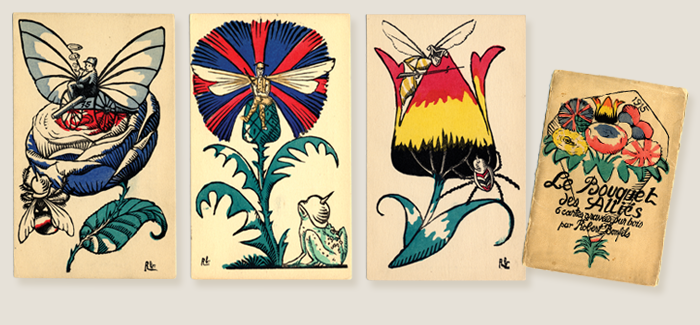
In 1915 Robert Bonfils published a set of six postcards, Le bouquet des alliés. Each ally is depicted as a flower: France as a rose, England as a thistle, and Belgium as a tulip. Threatened by a bug, spider, frog, snake, or caterpillar wearing the German pickelhaube, each bloom is defended by an insect soldier whose nationality is recognizable by his uniform or other details. Writes Edelstein in the catalog, “Bonfils has solved the problem of uniting these disparate countries in the most imaginative way, combining them in a bouquet of blooms, their diversity only enhancing the harmony of the whole.” (Publisher unknown, on loan from Richard Cheek)
French illustrators of World War I depicted the arena, the enemy, and the home front with bravura.
Of the artists and writers who documented the Great War a century ago, illustrators may be the most forgotten. In France, the pictures they made of life during wartime numbered in the thousands—part of the total mobilization of energies that the conflict called for, and the French delivered.
Inspired and often ingenious, the pictures were also ephemeral. With labor and paper in short supply, cheap production was sometimes the norm and many of the works are especially fragile. The artists’ names have largely faded from recognition over the decades, even in France. But more than 100 of the images can be seen this fall in the Regenstein Library’s Special Collections Research Center. En Guerre: French Illustrators and World War I, an exhibition curated by Teri J. Edelstein and Neil Harris, brings magazines, children’s and other illustrated books, calendars, and portfolios out of the library’s holdings and other public and private collections, showing off their color, immediacy, and visual force.
One of the most lethal conflicts in human history, World War I was “a total calamity and absurdity and a horror story,” says Harris, the Preston and Sterling Morton Professor Emeritus of History and Art History. Many of the pictures focus their attention away from the horrors, seizing instead on national pride, soldiers on leave, and life on the home front. Another strand vilifies and parodies the enemy. Rarer is work like the stark line drawings of Charles Martin, which, Edelstein says, “evoke the desolation, evoke the carnage, evoke the despair of the soldiers in the war.”
Several objects in the show are on loan from the curators, who have long collected French books and graphic arts as well as children’s books from Europe and the United States. Edelstein was surprised, in preparing the show, by how little of our contemporary understanding of World War I as a senseless disaster comes through in the artwork, even when many of the illustrators experienced combat, some suffering injuries or imprisonment. “No one was really exempt” from service, Harris notes, “no matter how talented or important.”
Some of the artists worked in stencils using bright hand coloring or in colored woodcuts, in each case with strong, simple lines. In the catalog Harris writes that the relative crudeness of such images “was meant to carry emotional weight, to call attention to itself, and to tap into a fount of memory and nostalgia.” Avant-garde art, particularly that from central Europe, was “treated as a pollution and infection” during wartime, he says. With the French revulsion toward these styles came a valorization of traditional and folk styles. Allusions to French history abound as well—to the French Revolution, Charlemagne, Joan of Arc, and the military triumphs of Louis XIV.
Every country involved in the war, of course, had its own chroniclers in words and images. For Edelstein and Harris, French illustration stands out. “The mobilization of the passion to support France and support the war effort was a great moment of creativity,” Edelstein says. And the French “had a running start” because of their investment in illustrated magazines and fashion illustration before the war, Harris adds. The exhibition, he says, is meant to suggest they “mobilized their cultural power to keep the population at large in support of what was becoming at some point a horrendous and totally crazy operation.”
